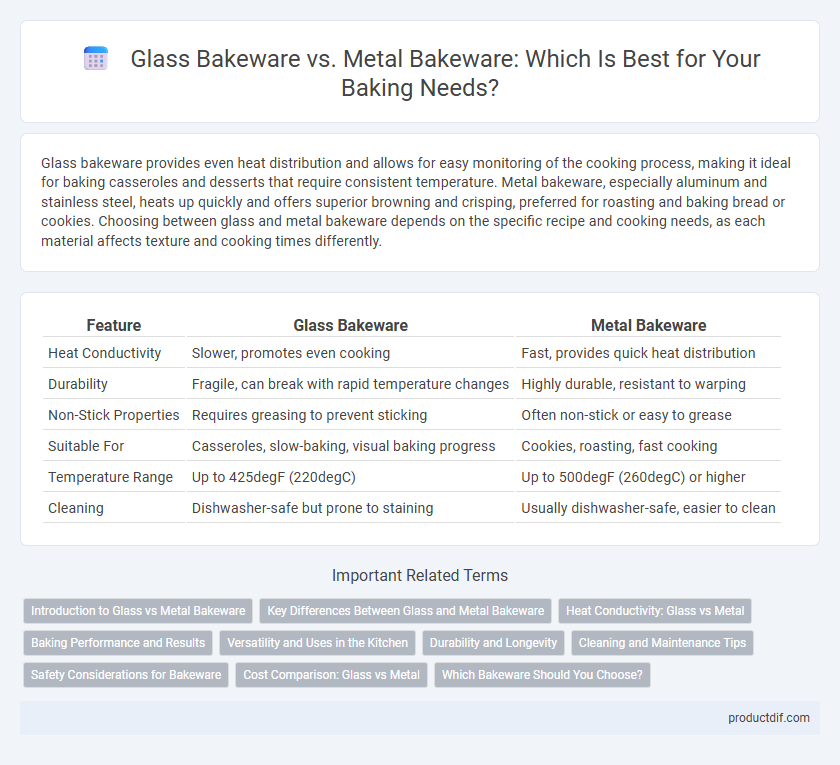Glass bakeware provides even heat distribution and allows for easy monitoring of the cooking process, making it ideal for baking casseroles and desserts that require consistent temperature. Metal bakeware, especially aluminum and stainless steel, heats up quickly and offers superior browning and crisping, preferred for roasting and baking bread or cookies. Choosing between glass and metal bakeware depends on the specific recipe and cooking needs, as each material affects texture and cooking times differently.
Table of Comparison
| Feature | Glass Bakeware | Metal Bakeware |
|---|---|---|
| Heat Conductivity | Slower, promotes even cooking | Fast, provides quick heat distribution |
| Durability | Fragile, can break with rapid temperature changes | Highly durable, resistant to warping |
| Non-Stick Properties | Requires greasing to prevent sticking | Often non-stick or easy to grease |
| Suitable For | Casseroles, slow-baking, visual baking progress | Cookies, roasting, fast cooking |
| Temperature Range | Up to 425degF (220degC) | Up to 500degF (260degC) or higher |
| Cleaning | Dishwasher-safe but prone to staining | Usually dishwasher-safe, easier to clean |
Introduction to Glass vs Metal Bakeware
Glass bakeware offers even heat distribution and excellent heat retention, making it ideal for slow, uniform baking. Metal bakeware heats up quickly and provides superior browning and crisping, favored for cookies and roasting. Choosing between glass and metal depends on the desired baking outcome, temperature tolerance, and recipe requirements.
Key Differences Between Glass and Metal Bakeware
Glass bakeware offers superior heat retention and even cooking, making it ideal for slow-cooked dishes and casseroles, while metal bakeware heats up quickly and provides excellent heat conduction for browning and crisping baked goods. Glass is non-reactive and resistant to staining, which preserves flavor integrity, whereas metal bakeware may react with acidic ingredients and can develop discoloration over time. The weight and durability differ as well; glass bakeware is heavier and prone to breaking under thermal shock, whereas metal bakeware is lightweight, more durable, and often coated with non-stick surfaces for easy release.
Heat Conductivity: Glass vs Metal
Glass bakeware heats more evenly but retains heat longer, which can result in slower cooking times and potentially uneven browning. Metal bakeware, especially aluminum and stainless steel, offers superior heat conductivity, promoting quicker and more uniform cooking with crispier edges. Understanding these heat transfer properties is essential for selecting the right bakeware to achieve optimal baking results.
Baking Performance and Results
Glass bakeware offers even heat distribution and retains heat longer, resulting in consistent baking and browning, especially for casseroles and pies. Metal bakeware heats up quickly and provides superior heat conduction for crispier edges and faster baking times, ideal for cookies and breads. Choosing between glass and metal bakeware depends on the desired texture and cooking speed for specific recipes.
Versatility and Uses in the Kitchen
Glass bakeware offers excellent heat retention and even cooking, making it ideal for casseroles, bread, and desserts that benefit from gentle, consistent heat. Metal bakeware heats up quickly and provides superior browning and crisping, perfect for cookies, pies, and roasting vegetables. Both materials complement each other in the kitchen, with glass suited for slow, even baking and metal excelling in high-heat, fast cooking tasks.
Durability and Longevity
Glass bakeware offers excellent durability with resistance to scratches and stains, maintaining clarity and performance over many years. Metal bakeware, especially aluminum or stainless steel, provides superior longevity through its robust structure and resistance to warping under high temperatures. Both materials excel in durability, but metal bakeware typically withstands more frequent heavy use without compromising shape or heat conduction.
Cleaning and Maintenance Tips
Glass bakeware is non-reactive and resists stains, requiring gentle cleaning with warm, soapy water and a non-abrasive sponge to prevent scratches. Metal bakeware, particularly non-stick varieties, demands careful maintenance to preserve the coating, using soft cloths and avoiding harsh detergents or metal utensils. Regular seasoning of uncoated metal pans can prevent rust and extend durability, while both types benefit from thorough drying to prevent damage and ensure longevity.
Safety Considerations for Bakeware
Glass bakeware is non-reactive and free from harmful chemicals like PFOA and PTFE, making it a safer choice for health-conscious bakers. Metal bakeware, especially aluminum, may leach trace amounts of metal into food when exposed to high heat or acidic ingredients, raising safety concerns. Both options should be inspected regularly for chips or corrosion to prevent contamination and ensure safe baking practices.
Cost Comparison: Glass vs Metal
Glass bakeware typically costs more upfront than metal bakeware due to its material and manufacturing process, with average prices ranging from $15 to $30 compared to metal's $10 to $20 per piece. Glass offers long-term value by retaining heat evenly and lasting longer without warping, potentially reducing replacement frequency. Metal bakeware, while generally cheaper initially, may require more frequent replacement due to warping or coating degradation, influencing overall cost-effectiveness.
Which Bakeware Should You Choose?
Glass bakeware offers even heat distribution and excellent heat retention, making it ideal for casseroles or dishes that require longer cooking times. Metal bakeware, especially aluminum or stainless steel, heats up quickly and provides a crispier texture, perfect for cookies or roasting vegetables. Choose glass for slow, consistent cooking and metal for faster, high-heat baking applications.
Glass Bakeware vs Metal Bakeware Infographic

 productdif.com
productdif.com